Spider Monkeys. Tarantulas. Alligators. The Bolivian Amazon Rainforest has it all!
Before planning my trip to Bolivia, I had no idea that the country is home to the southern part of the Amazon Jungle. It’s relatively under the radar which means fewer tourists and a more authentic experience in the wild.
Now that I’ve been there, and done that, I’m sharing all my tips so you can plan the perfect trip to the Amazon in Bolivia.
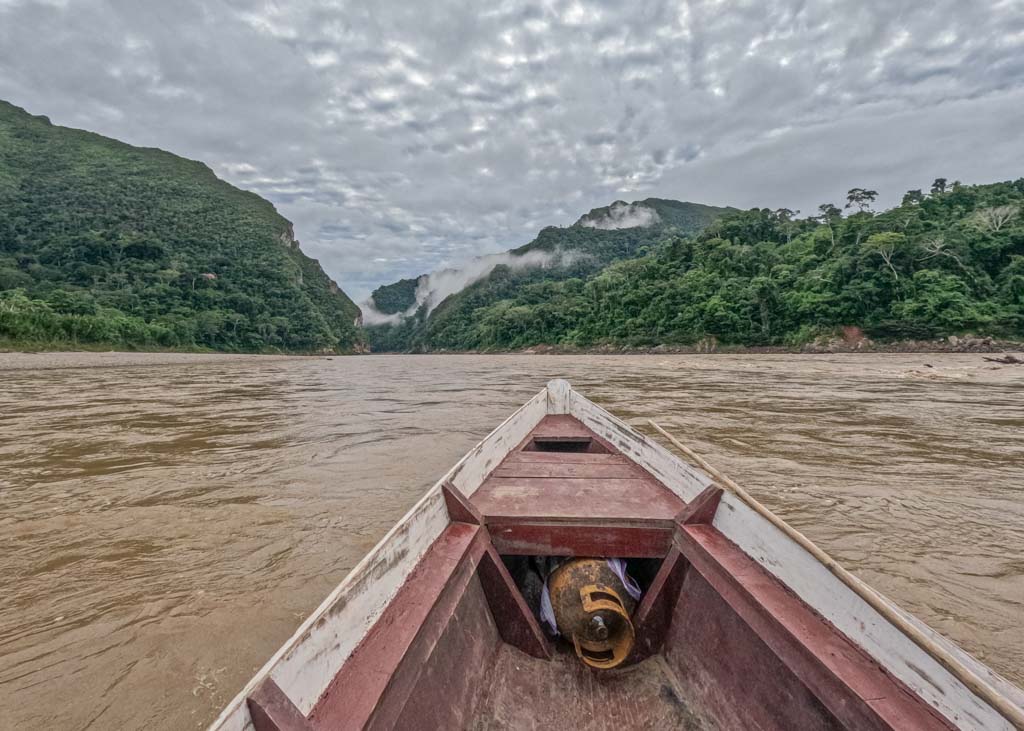
Quick Navigation
Best time to visit Bolivian Amazon
The best time to visit the Bolivian Amazon is during the dry season, from May to October.
But you’ll need to manage your expectations! It’s still hot and humid during this time, mosquitos are rife and you can’t rule out the occasional rainshower – it is the Amazon rainforest after all.
I visited the Bolivian Amazon in May and this is the perfect time to plan your trip (in my opinion). Why?
Because the conditions are optimal for trekking in the jungle as there is not much rain. And the water level in the Pampas is high enough so that your boat can easily navigate through the wetlands, yet low enough so you can see wildlife on the banks of the river.
During the rainy season (December to April), expect a lot more mosquitos, higher levels of humidity, and daily rain showers.
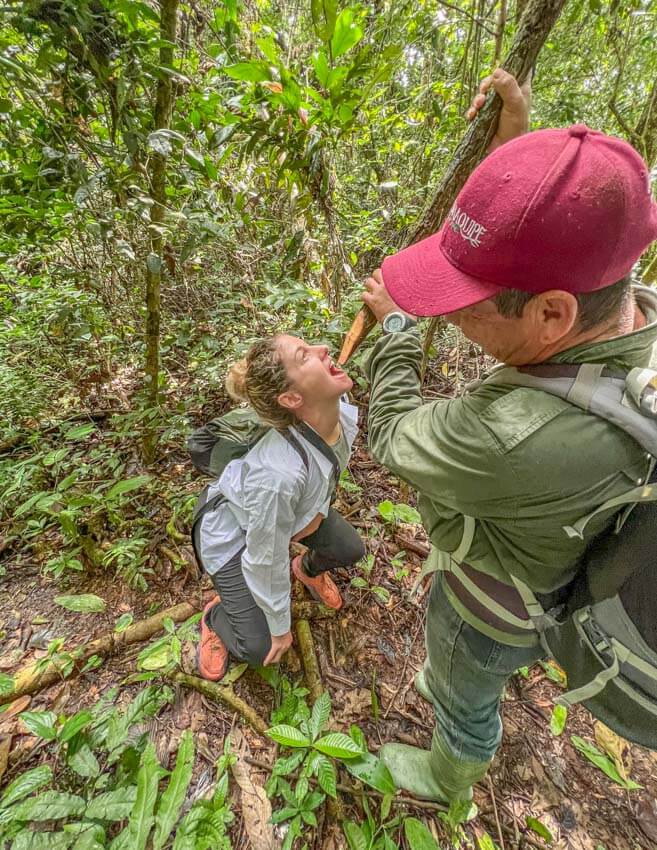
How to get to the Amazon in Bolivia
The small village of Rurrenabaque is the gateway to the Bolivian Amazon.
To get here, you can either opt for a short (but expensive) flight from La Paz or a much longer (and sketchy) bus ride.
Flight from La Paz to Rurrenabaque
Rurrenabaque is a quick 40 minute flight from La Paz.
Ecojet is the only airline that flies into Rurrenabaque with flights scheduled on Mondays, Wednesdays, and Fridays. Amazonas no longer flies to Rurrenabaque (despite what most blogs say).
The one-way flight from La Paz to Rurrenabaque will cost between 500 and 700 Bolivianos. It’s a pretty expensive flight but you’re paying for convenience.
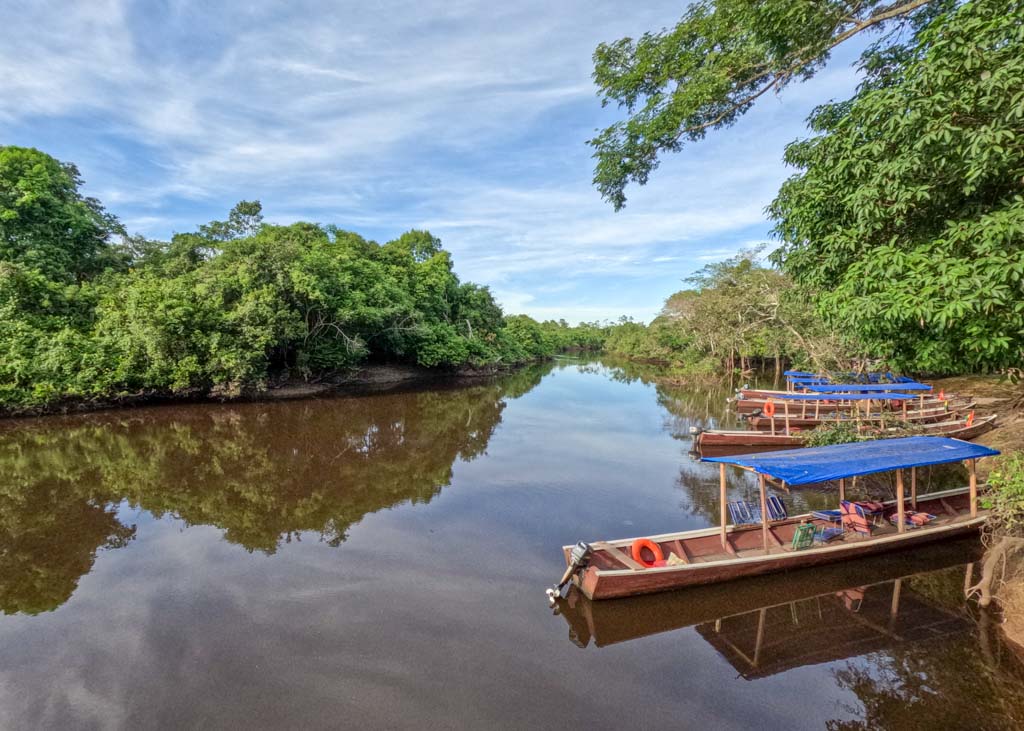
Bus from La Paz to Rurrenabaque
The bus to Rurrenabaque may be the cheaper option but it’s a long 12 to 18 hour ride, usually overnight. The road is not the best, with numerous twists and turns along the way.
Buses depart daily between 4 and 7 pm and there are various options to choose from.
I recommend booking with the bus company “Flota Yunguena” which is a full cama bus, meaning your seats can recline fully. This is the premium bus and costs 150 Bolivianos one way.
The only downside is that they don’t operate every day so you may have to opt for a regular bus instead.
Most people I met had taken the bus to Rurrenabaque and had no complaints – only that it was a long ride.
The bus journey was previously rumored to be unsafe due to the conditions of the road. But there has been work done to fix this and it’s now considered the best way to get to the Bolivian Amazon for budget backpackers.
How to visit the Bolivian Amazon
There are two ways to experience the Amazon rainforest in Bolivia. The first is from Madidi National Park, otherwise known as “The Jungle”. The second is from the Pampas.
Both are vastly different and are located a few hours from each other.
I did a combo tour but if you have less than 3 days, you will need to choose one or the other.
The Bolivian Amazon: Jungle (Madidi National Park)
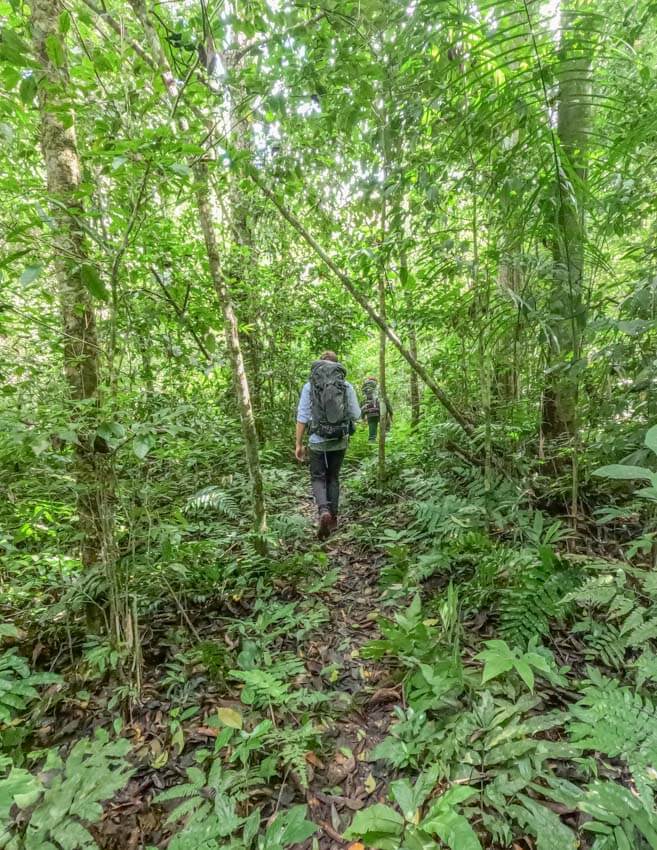
The Bolivian Amazon Jungle is where you go if you’re looking for a true jungle experience. It’s how I always imagined the Amazon to be.
You’ll be woken up to the sound of the howler monkeys and common sightings include tarantulas, frogs, butterflies, and snakes.
But, it’s an unforgiving place! The Bolivian Jungle is extremely humid and there’s no escaping the mosquitoes.
The dense forest and towering trees make it really difficult to spot wildlife, so don’t get your hopes up about seeing Jaguars or anything too exciting. But trekking through the jungle is an experience in itself.
The only way to access the Bolivian Jungle is to take a 3-hour boat ride from Rurrenabaque to Madidi National Park. From there, it’s a short trek into the jungle before getting settled into your lodge.
The Bolivian Amazon: Pampas
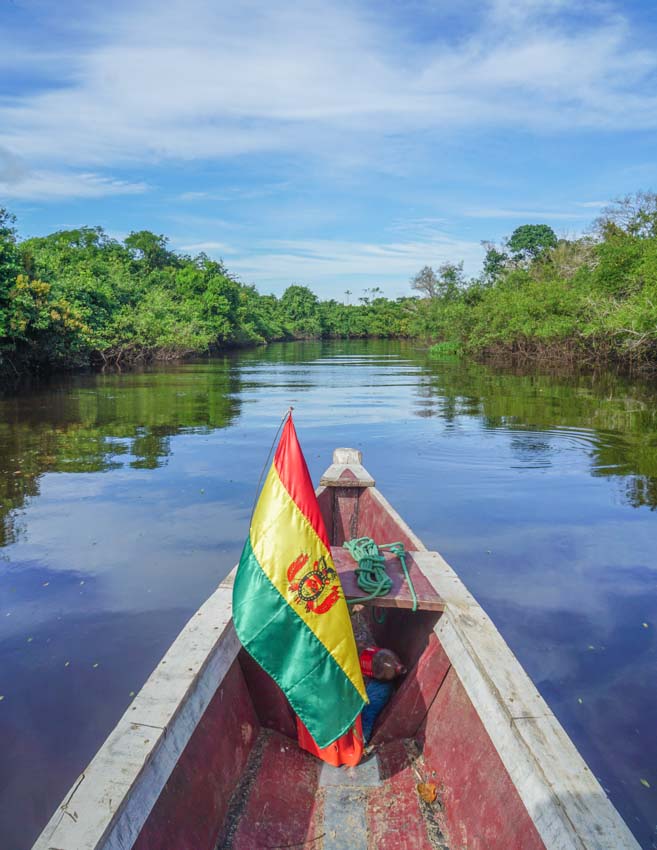
The Pampas couldn’t be more different from the Jungle. Most accommodation is in a riverside lodge and the only way to explore the wetlands is by small boat.
Visiting the Pampas is a more relaxing experience and less harsh when compared to the jungle.
It’s the more popular option and you’ll see more wildlife because there’s no dense forest.
Pink Dolphins, Squirrel Monkeys, Cayman, Alligators, Capybaras, turtles – you’ll spot them all. You can even go piranha fishing.
To get to the Bolivian Pampas, you’ll take a 3-hour car ride north of Rurrenabaque.
After spending 3 days in the Jungle and 2 in the Pampas, I preferred the Jungle because it really took me out of my comfort zone and was more physically demanding.
Combo tours
If you have the time and budget, I highly recommend doing a combo tour to experience both sides of the Bolivian Amazon.
You’ll need 4 nights for this, 3 of which will be in the jungle and 1 in the Pampas.
Costs to visit the Amazon in Bolivia
There is a perception that the Bolivian Amazon is “cheap” – it’s not. However, you can do it on a relatively low budget if you get a group of 4 or more travelers together.
Tour prices vary depending on whether you visit the Bolivian Jungle or Pampas, and the size of your group.
Here are prices to consider.
Park entry fees
- Madidi National Park (Bolivian Jungle): 200 Bolivianos per person
- Pampas: 150 Bolivianos per person
All inclusive tours (Approximate)
- 2N/3D Pampas tour: 1,000 Bolivianos per person
- 3N/4D Jungle tour: 1,500 Bolivianos per person
- 4N/5D Combo tour: 2,500 Bolivianos per person
Transport to Rurrenabaque
- Bus from La Paz: 150 Bolivianos (one way)
- Flight from La Paz: 600 Bolivianos (one way)
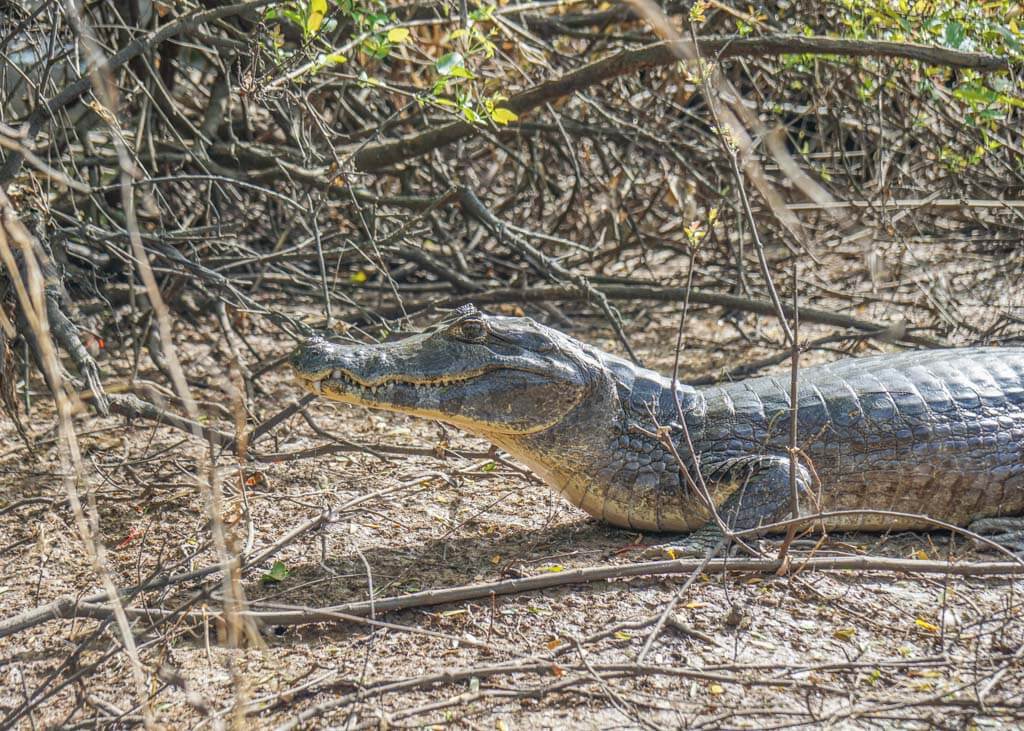
Bolivian Amazon tours
There are scores of tour operators in both La Paz and Rurrenabaque that offer all-inclusive packages to the Amazon in Bolivia.
If you’re doing only the Bolivian Jungle or only Pampas, then you’re spoiled for choice. But do your research on the company before booking with them.
Some operators use food to attract the animals and touch the wildlife – yes, I’ve seen pictures of people holding alligators.
Rather pay a bit more for an ethical company that respects the animals and pays their guides a decent wage.
You can also book a “Survival” tour of the Bolivian Amazon Jungle. You’re given a liter of water and a machete and are guided through the jungle where you make your own shelter and live off the land. It’s best to get a small group together and enquire about this when you arrive in Rurrenabaque.
My personal recommendation
If you’re doing a combo tour (as I did), I advise choosing an operator that manages both parts of the tour to ensure a seamless itinerary.
There’s a lot of logistical planning that goes into coordinating travel between Madidi National Park and the Pampas, and the last thing you want is to be waiting hours for your boat or car to arrive.
Having said that, if you’re on a tight budget, you can book with a cheaper operator but expect that there will be delays at some stage. You get what you pay for!
I booked my Amazon tour through Mashaquipe Eco Tours and highly recommend them. They did not know I was a travel blogger and I personally paid for the tour myself. It cost USD 440 for a 4N/5D combo tour and while they are the more expensive option, the tour was exceptionally well organized.
Tips for visiting the Bolivian Amazon
December and January is the peak wet season. This means lots of mosquitos. Like thousands! It makes the experience of trekking in the jungle almost unbearable. If you can, rather avoid visiting the Bolivian Amazon during these months.
There is an ATM in Rurrenabaque. Most places accept card payments, but there is a 3 to 5% surcharge.
You’ll need to cover up in the Jungle to protect yourself from bites. I bought a long white shirt in Rurrenabaque for 50 Bolivianos.
There are ticks. Thoroughly inspect yourself every night. Also, check your shoes before putting them on.
Camping in the Amazon is a once-in-a-lifetime experience. If you have the choice, go for it! But with the humidity and mosquitoes, it won’t be the most comfortable night.
Warning: No amount of DEET insect repellant will save you from the mosquitos in the jungle. I didn’t take anti-malaria medication and according to the locals, there isn’t malaria here (but you may want to do additional research on this).
You can visit the Amazon from Peru. If you’re traveling to Peru, you can also visit the Amazon Jungle from there. I explored both the Bolivian Amazon and Peru Amazon, and both were completely different experiences. I’ve shared my guide to visiting the Peruvian Amazon here.
Final thoughts on visiting the Bolivian Jungle
Exploring the Bolivian Amazon was a bucket list adventure for me. But it wasn’t pretty (well, the jungle part at least).
This made me appreciate the Amazon even more – from the medicinal value of the trees and plants, to the communities who call the Amazon home.
Like it? Pin it!
Do you have any questions about visiting the Bolivian Amazon Rainforest? Drop me a message in the comments section below!
Looking for more Bolivia travel inspiration? Check out my other posts!

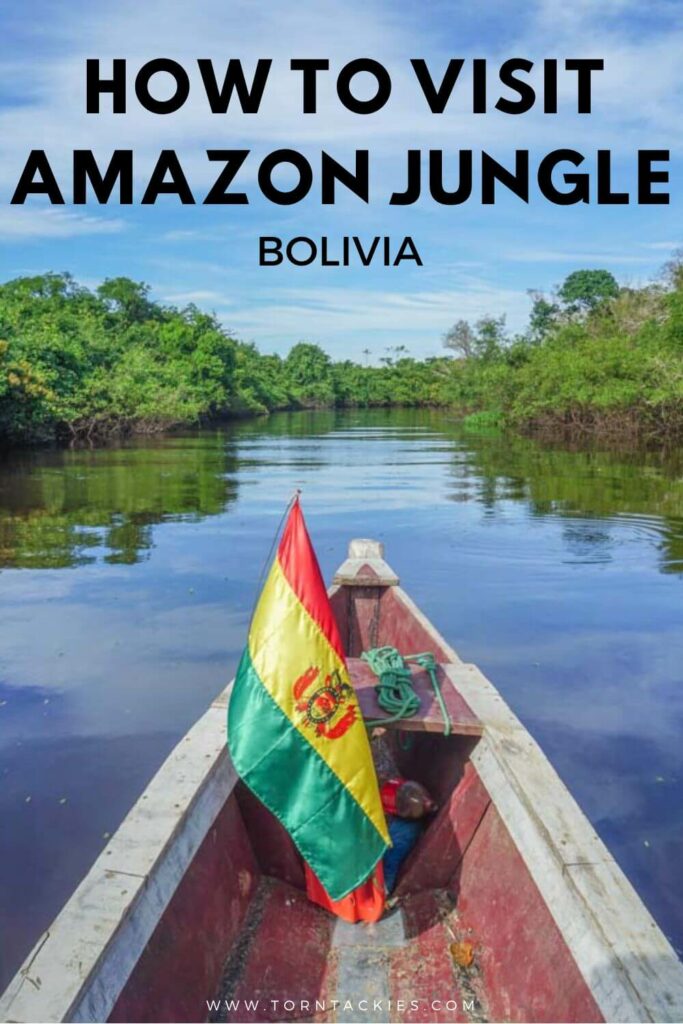

Hey Carin, amazing article and very helpful! Thank you for being honest at the end of it about all the cons sides!!! Happy travels!
Thanks Ivana. Have a great trip!
Hey Carin, thanks for the informative article! I am heading to Rurrenabaque for a volunteering project and would like to take the bus there! I was also recommended to book the Flota Yunguena but could not find much information online. If you have any advice on where to book, schedule etc it would be amazing thanks!
Hey Eylul,
Thanks for your message. I also found little information about the busses from La Paz to Rurrenbaque online. Are you spending some time in La Paz before heading to Rurrenbaque? Your accommodation will assist with booking your bus tickets if you ask them. I suggest sending them a message before you arrive to ask about dates and times.
Alternatively need to go to the bus station in La Paz (which is here) and make your booking in person. I’m not 100% sure if they depart from here but I’ve also found a number for them here which you can contact (I used Whatsapp for comms in Bolivia). Please let me know the outcome as I’m sure other readers have similar questions.
I booked my busses a day before and there was still availability.
Enjoy your time in Rurrenbaque.
Carryn